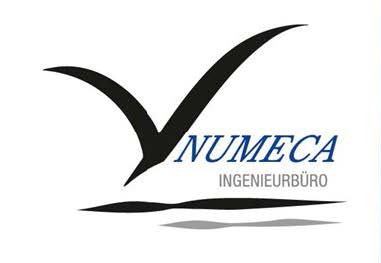Pipistrel reduces by 6% the Energy Consumption of an Electrical Aircraft by Optimising its Propeller with FINE™/Turbo
Aerospace | Turbomachinery | Grid Generation
Challenge
Improve the energy consumption of an electric aircraft through energy recuperation.
Solution
Pipistrel used the propeller as an airborne wind turbine, by transforming the energy created by the descension of an aircraft into electric energy and storing it in a battery. The performance of the propeller design was numerically computed with FINE™/Turbo.
Results
The aircraft consumes 6% less energy during the climb.
Net energy consumption during ascent/descent manoeuvres decreased by 19%.
A 27% increase in number of traffic pattern circuits was achieved.
The first electric aircraft was created by simply replacing the piston engine system of a normal combustion engine aircraft by an electric propulsion unit. Although environmentally friendlier, this was not an optimal design yet for an electrical aircraft.
Since the density of current state-of-the-art battery energy is still much lower than gasoline energy density, a need for optimal energy use in an electric aircraft is crucial.
Energy Recuperation as a Propeller Design Strategy
One possibility to improve the energy balance of an electric aircraft, is using its propeller as an airborne wind turbine, where the energy of a descending aircraft is recuperated into electric energy and stored in the battery.
In the case described in this article, Pipistrel designed a propeller specially adapted for exploiting in-flight power recuperation this way.
The objective was to improve the energy consumption of the Alpha Electro, Pipistrel’s electric trainer aircraft.
Climb is the most energy consuming part of the traffic pattern. A new propeller EA-002 (Figure 1) was designed to exploit the possibility of energy recuperation while preserving good performance in the climb flight phase.
Optimisation of the Propulsion System
For the optimisation of the propulsion system, a 3-way approach was performed:
- The Aerodynamic approach: focused on the optimisation of the airfoil shapes and the chord/twist blade distribution. The performance of the propeller design was verified through CFD simulations, ran with NUMECA software AutoGrid5™ and FINE™/Turbo. (The velocity distribution over a cross section of one of the simulations is presented on the right-hand side of Figure 2)
- The Electrical approach: includes a hardware enabled bi-directional energy flow, with the possibility to adjust the torque/angular velocity combination for maximum power recuperation at specific descent rates.
- The Strategic approach: focused on adjusting ascent and descent rates to minimise energy consumption and maximise energy recuperation respectively.
Methodology
The performance of the propulsion units was evaluated by comparing and testing 3 propellers with the following two testing methodologies:
(1) net energy consumption within 1000 ft ascent & descent manoeuvres and (2) the number of traffic pattern circuits performed with one fully charged battery.
The 3 propellers (Figure 3):
- The AS-D propeller was primarily designed for the piston engine version of the Alpha Electro, i.e. Alpha Trainer.
- The EA-001 propeller was developed for the Alpha Electro power train and optimised for climb and cruise phases.
- The EA-002 propeller was also made for the Alpha Electro power train, but optimised for climb and recuperation phases.
Climb & descent manoeuvres were tested according to these parameters:
- Climb phase manoeuvre: constant climb at 76 kts IAS for 1000 ft at 45 kW power – monitoring energy consumption, vertical speed and time to ascend.
- Recuperation manoeuvre: throttle idle, stable descent for 1000 ft at different speed rates – monitoring recuperated energy and descent rate.
Testing for the traffic pattern circuit with one fully charged battery included manoeuvres prescribed in the Alpha Electro Pilot Operating Handbook (POH) as follows:
- Climb/departure, crosswind and downwind cycle phases:
- apply take-off flaps below 60 kts indicated air speed (IAS)
- climb from 0 to 500 ft AGL by
- applying full power (65 kW) for first 10 s of the climb
- applying 70% (45 kW) power and climb at 76 kts IAS
- at 500 ft AGL apply 30% (20 kW) power and maintain 500 ft AGL
- Base, final, touch-and-go cycle phases:
- descend from 500 ft to 0 ft AGL by reducing power to idle
- apply landing flaps below 60 kts IAS
- descent at 50 kts IAS to the ground
Performance comparison
The results from the climb & descent manoeuvre tests are presented in Table 1.
The AS-D and EA-001 have similar climb performance and recuperation capability. With the EA-002 installed, the aircraft consumes 6% less energy during the climb compared to the AS-D propeller and is able to recuperate 0.15kWh at the descent speed of 70kts. The propeller optimised for recuperation (EA-002) showed a 19% reduction in net energy consumption compared to the EA-001.
As can be seen from Table 2, the test pilot was able to carry out almost the same number of traffic patterns with the AS-D and the EA-001 propellers, and 27% more (compared to AS-D) with the EA-002 propeller. This resulted in better climb efficiency and higher energy recuperation of the EA-002 at a relatively low approach speed of 50 kts, which was kept constant for all three propellers.
Experimental vs CFD Simulations
A comparison was performed between CFD simulation results and flight test measurements of the EA-002 propeller. Two parameters were compared: the thrust and the propeller power coefficient.
Figure 6 and Figure 7 depict values of thrust and power coefficients versus advance ratio of the EA-002 propeller respectively. As seen in the figures, the design predictions of NUMECA’s CFD simulation results and the flight test measurements of the propeller are in good agreement.
Conclusions
Due to the reduction of the energy consumption, the aircraft can stay airborne longer and/or smaller battery packs may be installed for a specific flight time.
The EA-002 is set to become the first European Aviation Safety Agency certified propeller with recuperation capability for electric propulsion.
Authors
D. Eržen, M. Andrejašic, R. Lapuh, J. Tomažic and C. Gorup – Pipistrel Vertical Solutions d.o.o., Slovenia T. Kosel – Faculty of Mechanical Engineering, Slovenia
Full Journal Paper
D. Eržen, M. Andrejasic, R. Lapuh, J. Tomazic, C. Gorup, and T. Kosel, “An Optimal Propeller Design for In-Flight Power Recuperation on an Electric Aircraft”, 2018 Aviation Technology, Integration, and Operations Conference, AIAA AVIATION Forum, (AIAA 2018-3206)
Products
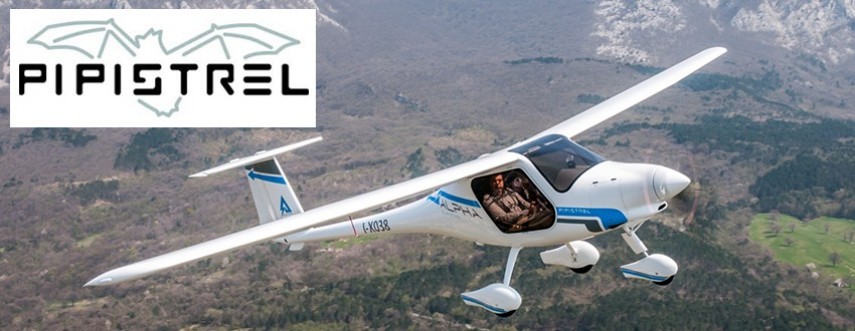
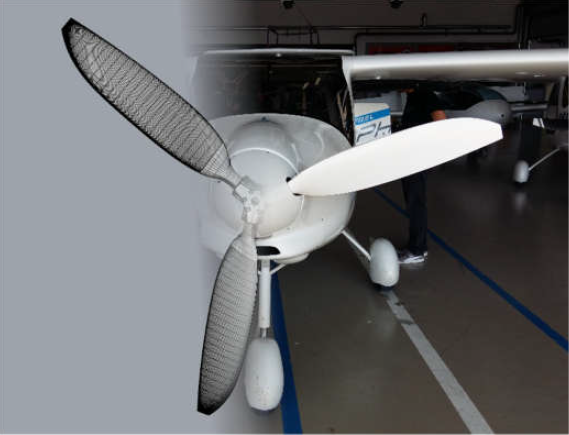 Figur 1: New propeller design
Figur 1: New propeller design 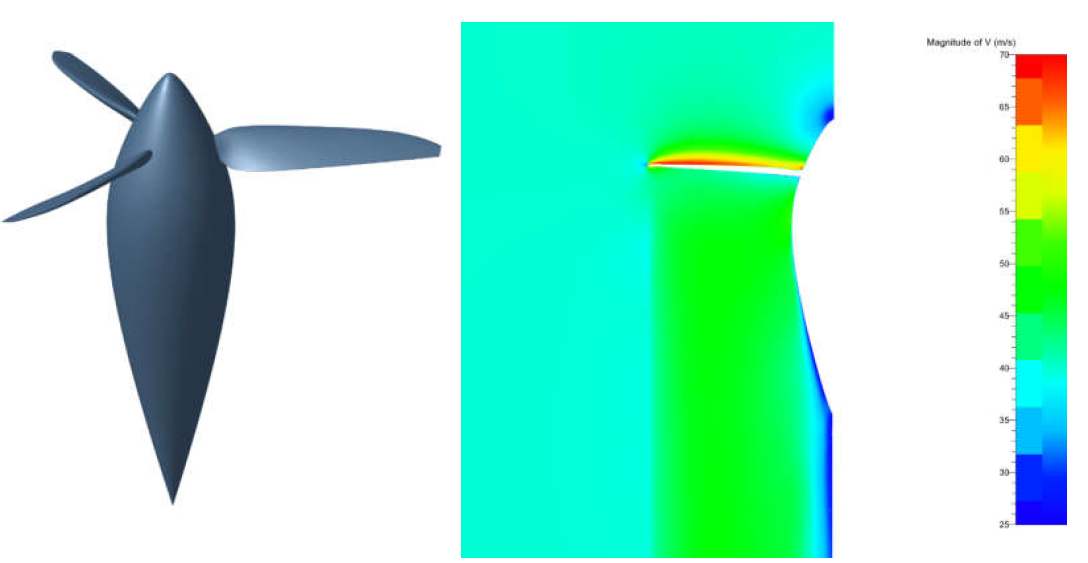 Figur 2: CFD geometry and velocity distribution over a cross section
Figur 2: CFD geometry and velocity distribution over a cross section  Figure 3: Propellers from left to right: Pipistrel AS-D, EA-001 and EA-002 (installed on Alpha Electro).
Figure 3: Propellers from left to right: Pipistrel AS-D, EA-001 and EA-002 (installed on Alpha Electro).  Figure 4: Performance comparison
Figure 4: Performance comparison  Figure 5: Number of traffic pattern circuits
Figure 5: Number of traffic pattern circuits 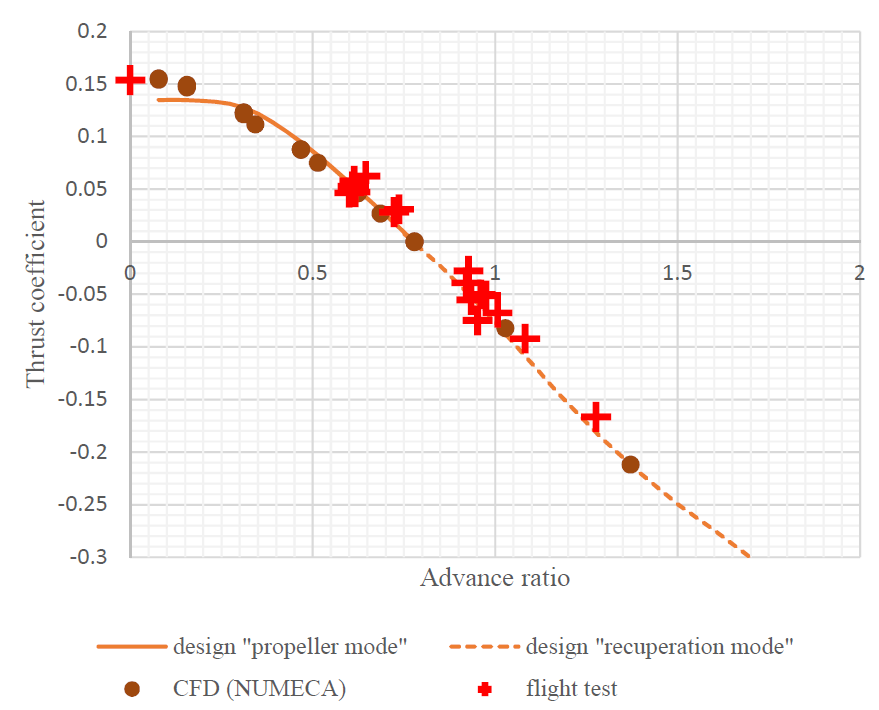 Figure 6: Design predictions, CFD and test flight measurements of the thrust coefficient for EA-002 propeller versus advance ratio
Figure 6: Design predictions, CFD and test flight measurements of the thrust coefficient for EA-002 propeller versus advance ratio  Figure 7: Design predictions, CFD and test flight measurements of the power coefficient of the EA-002 propeller versus advance ratio
Figure 7: Design predictions, CFD and test flight measurements of the power coefficient of the EA-002 propeller versus advance ratio 